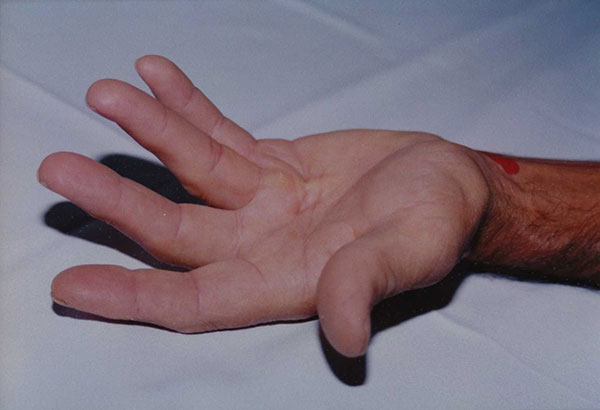Dupuytren’s (Palmar Fibromatosis) Surgery
If you’re considering a hand surgery for Dupuytren’s Contracture in Auckland and are looking for the most refined results possible, here’s what you need to know about Dr John de Waal’s tailored approach.
What is Dupuytren’s Disease (Palmar Fibromatosis)?
Dupuytren’s Contracture is named after prolific French researcher Baron Dupuytren, who pioneered much of our initial understanding of this hand condition in the 1800’s.
Dupuytren’s is a common issue where dense fibrous tissue (fascia) under the skin of your palm thickens, tightens and grows like a benign tumour. It usually grows up along your ring finger and pinky finger, and once it grows above your knuckles, your fingers will start to bend towards your palm. In severe cases, these fingers contract to become ‘hooked’ and immobile. The condition is usually painless, but can affect your day-to-day activities and self-confidence.

What causes Dupuytren’s Disease?
It is not yet clear what causes Dupuytren’s Disease, but it is most common in older men from families with Celtic and Western European origins. There is no absolute cure, but surgical hand contracture treatment is relatively straightforward; we regularly perform this procedure and deliver excellent results. Treatment before the joints bend more than 20° can usually completely correct your hand deformity.
What are the early symptoms of Dupuytren’s Contracture?
If you have Dupuytren’s Disease, you may first notice one or two small ‘lumpy’ nodules developing under the skin of your palm. These nodules will slowly form into longer cord-like structures that start to make it difficult to straighten your hand. If you notice nodules forming, consult your GP. Treating the initial signs of Dupuytren’s is far simpler and less invasive than a full hand contracture surgery.
Dupuytren’s Disease Treatment Options
If you have had a Dupuytren’s Contracture diagnosis, there are several treatment options available. We recommend different Dupuytren’s treatments depending on the severity of your contracture, but a hand surgery is usually most effective. The aim is always to break up the thickened fascia and free up the fingers from their ‘pull’.
Dupuytren’s hand surgery techniques: Fasciectomy
A fasciectomy procedure is usually the most effective and long-term modern solution for Dupuytren’s Contracture. Our team is highly specialised in this advanced treatment technique. We use very small incisions to partially or completely remove sections of the diseased tissue and gently manipulate your hand joint cartilage to straighten your fingers. We usually perform this surgery under a general anaesthetic.
Dupuytren’s hand surgery techniques: Fasciotomy
A fasciectomy (splintage) procedure is an older and less invasive type of Dupuytren’s intervention. We simply break up the ‘cords’ using a scalpel; this decontracts your palm and fingers. We usually perform the procedure using local anaesthetic. With proper aftercare and physiotherapy, the results of a fasciotomy can last for several years.
Non-surgical ways to treat Dupuytren’s Disease
Needling for Dupuytren’s Contracture
A hand needling procedure works in a similar way to a fasciotomy, but breaks up the ‘cords’ using a small needle instead of incising with a scalpel. If you have early signs of Dupuytren’s, needling can slow the fascia thickening process without surgery, but contractures tend to recur at a faster rate.
Enzyme or steroid injections for Dupuytren’s Syndrome
Certain enzymes (called collagenases) and steroids can dissolve small Dupuytren’s nodules via injection into your hand and finger joints. This requires multiple sessions, at least one month apart. Recurrence is common after an enzyme injection course.
Home treatments and physiotherapy for Dupuytren’s Contracture
While neither home treatments or physiotherapy can completely fix Dupuytren’s Disease. However, there are several things you can do to protect your hands and slow the contracture process:
- Finger and palm stretching
- Applying massage and gentle heat to release the tightened tissues
- Avoiding gripping objects tightly
Radiotherapy for Dupuytren’s Syndrome
Radiotherapy for Dupuytren’s Contracture has been reported to be of some benefit in slowing the disease progression.
Asking questions and knowing what to expect on operation day is an important part of the facelift procedure.
Before your hand surgery in Auckland, Dr de Waal will talk you through the operation and draw planned incisions on the area to make sure that they align with your expectations and what has been discussed in your consultations. You’ll then be placed under anaesthesia before the Dupuytren’s operation takes place.
The procedure takes between 1-3 hours per hand, and you will not need to stay in hospital overnight.
Dr de Waal takes special care in every operation, using advanced techniques and his extensive experience to ensure minimal scarring and bruising to help with hand surgery recovery. Here’s what to expect after a Dupuytren’s treatment procedure:
- Directly after the surgery, we will apply firm padded bandaging with a splint, and put your hand in a high sling to reduce swelling.
- We will make an appointment to remove your stitches and bandages after 7 days. Sometimes, we postpone the removal depending on how your healing is progressing.
- You may experience swelling and minor discomfort, which should dissipate within 3-16 weeks.
- We recommend that you plan about 1-2 weeks of time off work and less strenuous activities like driving, and that you avoid the gym, strenuous activities and heavy lifting for 6-10 weeks.
- Physiotherapy is essential to help you regain full use of your hands after surgery. We will recommend a trusted hand therapist and treatment plan.
Unfortunately, no Dupuytren’s treatment is permanent, but we will ensure that your surgery is as effective and long-lasting as possible.
*recovery times are approximate and dependent on the individual and their procedure.
Implications for any surgery are typically unlikely with proper care. However, like all surgeries, there is always a risk of bleeding, infection and bad reactions to anaesthesia. Typically, hazards are minimal for healthy hand plastic surgery candidates who follow pre-surgery and post-op instructions.
Common (temporary) surgery risks:
- Bruising
- Swelling
- Temporary numbness
- Discomfort on movement
Infrequent surgery risks:
- Infection
- Bleeding (haematoma)
- Delayed healing
- Poor scarring
Before any procedure, Dr de Waal will discuss any potential risks and make sure that you fit the profile of a healthy Dupuytren’s surgery candidate.

